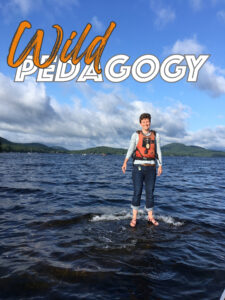
I would, but…
 The conversation goes like this:
The conversation goes like this:
“I saw you having class outside today.”
“Yep! Great day!”
“Don’t students get distracted outside?”
Or …
“I would do that, but I have PowerPoints.”
Or…
“I would, but I have 35 students.”
Or…
“What do you do with students who don’t want to?”
I have this conversation at least twice a week. More when the weather is nice.
So, for those of you who are intrigued by the idea, but have your own questions, I offer a practical guide to teaching outdoors. For context, I teach at a small liberal arts school where most of my classes are 30 students. I have taken classes of 38 outdoors, and yes, 12 or even 20 is easier, but it works with more, too.
First, to the “I would, but I use PowerPoints” (or other technology), my answer is blunt. I don’t use them. I encourage you to allow the limit (not being able to use plug-in-able technology) and the new space (outdoors) to engender your creativity. How could your classroom be more active? Do you really need that one picture, or can you describe a thing to your students? This might be something my discipline allows for more than others: I don’t need diagrams unless I’m teaching Origen’s theology of the fall of souls. There are times I want a whiteboard, but even then, I find that if I tell students, “If I had a board I’d be writing this down,” they begin writing in their notebooks as if I had. I might spell a word or two that I would normally write, and I repeat myself more outdoors, making sure they catch the main ideas. It actually makes me a more attentive teacher.
Some students do not want to go outdoors, or are allergic to grass, and many students do not like wet butts from dewy lawns. If it is borderline too cold, I give them the option and let them vote. Otherwise, on the first day of class in the fall and the first nice day in the spring I inform students that we will be outside and they should come prepared—bring something to sit on, layers and sunscreen. I recommend black pants in case the grass is still wet with dew or sprinklers so no one will be able to tell they are wet. I myself wear black pants for this reason, though like Elizabeth Bennett I don’t care if I have grass stains when I forget. Usually when it is nice the majority of the class wants to be outside, so I have no problem. No one has ever voiced serious hatred or concern.
The question of accessibility is real. I have not yet had a student in a wheelchair, but I have had students on crutches and students allergic to grass. Wherever we are going to be, we have taken an accessible sidewalk to get there, so I simply position us close enough to the sidewalk so that students who want or need to sit on the sidewalk instead of the grass may do so. Often there are small walls or benches I can choose to be near if a student can’t get all the way to the ground. And always I tell students they are welcome to stand rather than sit for class.
The other major accessibility consideration is hearing. It can be harder to hear outdoors because of ambient noises or simply the fact that they may sit farther away and my voice not carry as far in the open air. To be honest, there are times students have trouble hearing because lawn mowers decide that is the best time to mow the section of the quad next to where we are sitting. I joke about the lawn mowers so students know I am aware of the issue but continue teaching. They are never so close for so long that I cannot hold a lesson. If mowers get really close, I have students talk in small groups for a bit so they can be near and hear each other. For general hearing considerations, I stand rather than sit with them if it’s going to be an issue. If there is a particular disability, I make sure to sit or stand close to that student and make sure they can see my lips. I also repeat student questions and comments when students are not themselves loud enough during whole-class discussion. Additionally, I remind students to sit close together outside. They tend to spread out farther than they do in the classroom, and a simple reminder helps.
Finally, the big question: Do students get distracted outside? Yes. But they get distracted inside, too. At least outside they are distracted by more interesting things. I find I am less bothered by it, at least. And in the end, the conversations, exams, and papers show that they are learning just fine. Because they’re doing it with a breeze in their hair, I think they’re learning more than fine.
Thank you for this nudge in the right direction! In recent semesters “inside” somehow has become my default setting–even when I went for a walk as soon as the class was over! I agree that it’s much better when students get “lost” staring out over grass and trees than into the same old screens. Again, thanks for daring to engage the world and to encourage students to do the same.